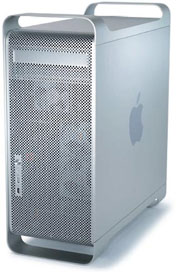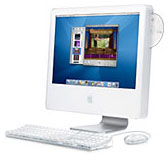On June 23, 2003, Apple introduced the first Power Mac G5, which represented some big changes from the G4. The Power Mac G5 was the first Power Mac with built-in USB 2.0, the first to use PCI-X expansion slots, and the first with onboard support for SATA drives. It was also the first Mac to hit the 2 GHz mark.
 The G4 CPU had been a Motorola exclusive, and Motorola just couldn’t deliver the clock speeds to keep Macs competitive with Pentium PCs. Apple prevailed upon IBM to develop a next generation PowerPC CPU that would run faster and include the “velocity engine” optimizations found in the G4’s AltiVec.
The G4 CPU had been a Motorola exclusive, and Motorola just couldn’t deliver the clock speeds to keep Macs competitive with Pentium PCs. Apple prevailed upon IBM to develop a next generation PowerPC CPU that would run faster and include the “velocity engine” optimizations found in the G4’s AltiVec.
The big difference is that where the last versions of the G4 ran on a 167 MHz memory bus (the 1.42 GHz CPU in the top-end Power Mac G4 ran 8.5x as fast as its memory bus!), the G5 used memory running at one-half or one-third of CPU speed, so the entry-level 1.6 GHz G5 had 533 MHz memory while the top-end 2 GHz version used a 1 GHz data bus. (Later on, some low-end G5 Power Macs would run memory at one-third of CPU speed.)
The drawback was that the G5 ran hot, forcing Apple to design an entirely new enclosure, and some versions of the Power Mac G5 – the 2004 2.5 GHz dual, Early 2005 2.7 GHz dual, and Late 2005 2.5 GHz Quad – used liquid cooling in addition to the more traditional air cooling. The fastest, hottest G5 Power Macs had some reliability issues that were more common than on slower versions.
Although the Power Mac G5 disappeared from Apple’s stores in mid-to-late 2006 as the company transitioned to Intel, those old G5 Power Macs remain useful.
Austin Leeds (Apple Everywhere): Having used a liquid-cooled Power Mac G5 alongside some (then) modern 2009-2010 iMacs, I was always surprisingly pleased by the aura of incredible power the G5 emitted. Maybe it was the fans or the big speakers hooked up to it, but the G5 seemed to preside over the room – that is, until someone turned it off over the summer and the coolant leaked. Sigh, I’m gonna miss those fans….
Phil Herlihy (The Usefulness Equation):Yeah, we had massive coolant system failures here, I saw the demise of five different G5 towers, all beasts. I attempted repairs on them, but the coolant was quite corrosive and could ruin motherboards quite quickly.
It seems the longevity of the air-cooled systems is also reduced. My G4 Digital Audio ticks on, but my Dual 2 GHz and Dual 1.8 GHz G5s both suffer from random kernel panics and shutdowns. I have yet to fully diagnose one, but my best guess is that the capacitors in the power supply have failed. The power supplies on this systems are constantly ravaged by the power hungry G5 processors.
Another quite common failure mode was the power supply simply burning up. (Slow failure symptoms of this are usually failure to wake from sleep, random kernel panics, random episodes of what seems like the computer falling asleep.)
That said, they pack quite a punch and were able to pummel most games of the time. I’m sure one could still be used as a decent photo editing station, even today. The enclosure is also a tank. They make great seats, and I’m in the process of turning a couple into a nice glass coffee table. That’s got to say something about the design.
Dan Knight (Mac Musings): Yes, Apple really pushed the envelope to get the G5 out the door while trying to avoid overheating. Back in June 2006, MacInTouch compiled data about over 3,000 G5 Power Macs and reported reliability rates for the various classes of problems. In every case except for the Late 2005 model, which was still quite new at the time, the middle speed model had the highest reliability, the fastest model the worst reliability, and the low-end model fell between the two extremes.
- G5/1.6 single (June 2003), 24%
- G5/1.8 single (June 2003), 19%
- G5/2.0 dual (June 2003), 32%
- G5/1.8 dual (Nov. 2003), 27%
- G5/1.8 dual (June 2004), 19%
- G5/2.0 dual (June 2004), 17%
- G5/2.5 dual (June 2004), 26%
- G5/1.8 single (Oct. 2004), 19%
- G5/2.3 dual (April 2005), 11%
- G5/2.7 dual (April 2005), 22%
- G5/2.0 dual-core (Oct. 2005), 18%
- G5/2.3 dual-core (Oct. 2005), 18%
- G5/2.5 quad-core (Oct. 2005), 17%
These numbers indicate any type of repair, ranging from logic board failure to having to replace the optical drive, and six years later it’s very likely that any used G5 you may buy does not have these problems, although you’ll still want to be careful with the dual 2.5 GHz and 2.7 GHz models, which are noted for coolant leaks. (The Late 2005 2.5 GHz Power Mac G5 Quad used a whole new liquid cooling system.)
Dan Bashur (Apple, Tech, and Gaming): Although I have never owned a G5 Mac, my brother has one which is still his main workhorse (a 2004 dual 1.8 GHz unit), while a 1.42 GHz iBook G4 currently supplements for portability. The dual G5 right after a start-up seems like a hot rod revving it’s engine compared to most G4s I know of.
At the time when my brother got his dual G5 brand new in 2004, he was a film student at Point Park University and really appreciated how his G5 would power through Final Cut Pro (at the time I was still rocking my much slower 600 MHz iMac G3). Armed with a portable 250 GB hard drive, he was able to easily go back and forth between lab courses and home to work on projects without skipping a beat due to this being nearly top of the line for its day. Now, with eight years of service behind it, his G5 certainly has given him a satisfying, lengthy experience, and when the time is right he most likely will be upgrading to a late model Mac mini.
Even though OS X 10.5 Leopard (the last OS that a G5 and most G4s can run) will be three generations removed quite soon with OS X 10.8 Mountain Lion, it doesn’t mean that this G5 or any other G5 will be less useful. The G5 certainly can run plenty of fairly modern productivity software (especially dual processor/dual-core units) and can still be a great media server with room for several modern large capacity SATA hard drive bays.
Sadly, the major drawback of the G5 is the amount of heat it emits, and that is what makes them sound like a small jet engine in takeoff when the fans are running at full force. This heat problem is the likely a cause of many premature hardware failures and why we never saw a PowerBook G5, resulting in a swift end to the PowerPC era and the beginning of x86 Intel-based Macs. Who would have guessed in 2003 and 2004 that the end of PowerPC architecture on our beloved Macs was so close? Thanks for all the memories, G5, and for being part of the very last batch of machines we used to call “Power Macs.”
Allison Payne (The Budget Mac): I haven’t used a G5 personally, but we just phased the last ones out at my day job supporting the photo/video folks in my department. They’re beasts, and I mean that in the best sense. I was always tempted to buy one when I’d see good deals on LEM, but I could never find a use for a machine with that much power.
As for the case design, it’s held up pretty well to still be in service with the current Mac Pros, although carrying one around can be painful. Yes, built-in handles are brilliant, Apple; now how about rounding the edges a little him?
 Alan Zisman (Zis Mac): No one has mentioned the G5 iMacs – the first incarnation of the slab-style iMacs that are still (with modifications of design, and of course, Intel processors) in use today.
Alan Zisman (Zis Mac): No one has mentioned the G5 iMacs – the first incarnation of the slab-style iMacs that are still (with modifications of design, and of course, Intel processors) in use today.
I had one for review and later purchased one, and found it – design-wise, a stunner – light-years more attractive than the “Luxo-lamp” styled G4 iMac.
Dan Knight: The G5 iMacs never ran at the blistering speeds of the G5 Power Macs, and with only a single CPU, they didn’t need excessive heating. The Late 2005 iMac was also Apple’s first desktop computer with a built-in webcam, and it’s one model I would like own myself someday.
Allison Payne: I do like the design of the G5 iMacs, but I’ve dealt with a string of leaky capacitors in those models, so I generally avoid them like the plague. It may not be fair to the perfectly-reliable units out there still going strong, but I just don’t want to bother anymore.
Charles W Moore (several columns): Like several others here, I have never owned a G5 Mac. My brother-in-law did have a G5 iMac, which didn’t commend itself by failing suddenly and catastrophically when it was about four years old. He replaced it with a Core i3 iMac.
For me, the fact that no G5 powered laptop was ever released pretty much ruled G5s out by default. Reportedly Apple did develop some G5 PowerBook prototypes but could never get the extreme heat issues dealt with satisfactorily, which likely influenced the 2005 decision to switch to Intel x86 silicon in early 2006, which in hindsight was the right call in several contexts, with the transition having been relatively smooth and painless – aside from Apple’s recent and gratuitous determination to purge backwards compatibility with PowerPC software.
Jason Schrader (Maximize Your Mac): I have owned three Power Mac G5s: a dual 1.8 GHz and two 2.0 GHz in differing versions. My favorite was the last revision they built with a 2.0 GHz dual-core CPU.
It was old tech when I owned it, but it was fun to play with. They are still useful to this day. The case was a beautiful design. There were flaws though, like having only two hard drive bays and the amount of power they needed. I have another one on the way. I don’t know the specs, but I can’t wait to work with it. I no longer have any Macs in the house, and that just seems wrong to me, as I love OS X.
I have both the G5 iMac and a Core iMac at school. The G5 is particularly noisy. I have another G5 iMac coming this fall for my art room. I hope they hold up.
Short link: http://goo.gl/4qDi15
searchword: g5legacy

